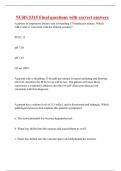Exam (elaborations)
NURS 5315 Final questions with correct answers
- Course
- Institution
A patient in respiratory distress and is breathing 33 breaths per minute. Which ABG value is consistent with the clinical scenario? PCO2 15 pH 7.30 pH 7.45 O2 sat 100% A patient who is breathing 33 breaths per minute is hyperventilating and blowing off CO2; therefore the PCO2 level w...
[Show more]



